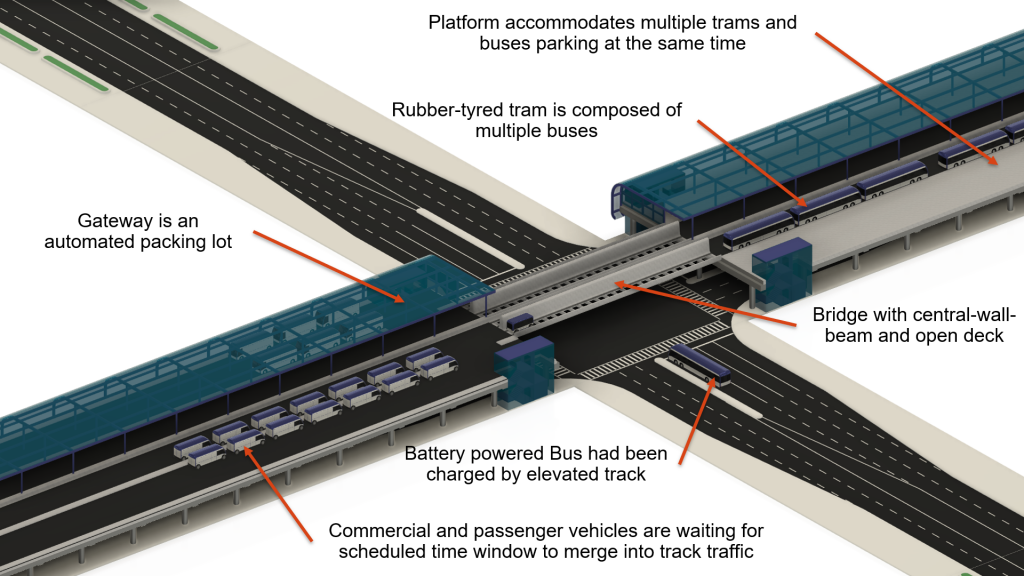The Rotao hybrid transportation system is a multi-layer transportation system formed by adding Rotao elevated tracks and ancillary facilities above the original road traffic. The transportation system is called a hybrid transportation system not only because it applies both ground-level and elevated transport, but also because the elevated track can be used by a mixture of buses, commercial vehicles, and private cars.
Urban rail transit and buses include most of the applications of urban public transportation. Urban rail transit includes subways, light rails, monorails, suspended monorails and street cars, etc., which are used on routes with higher ridership. Buses are used on routes with lower ridership. Rail transit usually uses overhead or tunnel methods in areas with high population density and more congested traffic.
The current urban rail transit has the following challenges or shortcomings: (1) The insanely high construction cost of the elevated structures or underground tunnels; (2) the long construction period with impact of surrounding communities; (3) the long station spacing and the long walking distance from the ground to the platform; (4) The excessively high turnout construction difficulty which limits the flexibility of the application; (5) The low friction coefficient between the wheel and the track , which leads to a long acceleration and braking distance, and also limits its use on slopes and use on wet and slippery areas covered by rain and snow.
Current city buses have the following challenges or shortcomings: (1) The short stop spacing leads to the low operating speed; (2) The limit capacity of buses requires more drivers, it increases the operational cost; (3) Affected by other traffic, punctual operation cannot be guaranteed during peak hours; (4) It is more susceptible to weather; (5) The noise and pollution problems of diesel buses; (6) The battery capacity and charging difficulties of electric buses.
In summary, no matter the existing rail transit or buses, they have their inherent limitations. The Rotao hybrid public transportation system, as a part of a new generation of the transportation system, can adopt the points of rail transit and buses and avoid their shortcomings. It will become the optimal choice for urban transportation and even intercity transportation in the foreseeable future.

The Rotao hybrid transportation system includes the existing surficial transportation and the elevated track built above it. The speed limit for ground transportation is compliant with the surficial traffic regulations, usually 50-60 kph. The speed limit on the track is 80-90 kph in urban areas and residential areas, 110-120 kph in suburbs and industrial areas, and 140-150 kph in outer suburbs and intercity. These limits are estimated according to the noise impact of the surrounding environment by high-speed traffic. If only based on safety and reliability considerations, the speed may be higher.
All vehicles of the Rotao Hybrid Transportation System are compatible with the Rotao track standard. Including but not limited to: (1) Wheel track meets or can be dynamically extended to Rotao standard track width; (2) All wheels are steerable independently; (3) The vehicle is powered via collector shoes beside the wheels (4) The steering roller guidance ensures additional safety; (5) Compatible with the Rotao track communication protocol, the vehicle is dispatched and driven by the Rotao track central control system, known as “passive driving”. For other features of Rotao vehicles, please refer to the introduction of “IPASS Wheel Unit”.
The Rotao elevated track has the following main features: (1) The highly modular production and erection mode reduces construction time and cost, and reduces the impact on surrounding communities; (2) powers vehicles on the track and charges the vehicle’s batteries. (3) The elevated track does not affect ground traffic with long girder span and no road width reduction. (4) The optimization of the vertical space can ensure that the elevated track deck is lower, and the urban rail will expand to form a multi-layer rail transit in the future. At the intersection of the two tracks, the upper track can still keep a lower deck height. For other features of Rotao Elevated Track, please refer to the introduction of “Rotao Elevated Track”.
The public transportation part of the Rotao mixed transportation system includes 3 or 4 types of public transport vehicles: (1) express trams running on the track, with a station spacing greater than 10 kilometers, with an average speed of 80-100 kph; (2) rapid trams running on the track, 2 -4 kilometers station spacing, with an average speed of 40-60 kph; (3) buses running on surface roads, 300-500 meters stop spacing, with an average speed of 16-20 kph; (4) shuttle buses mainly running in the community neighborhoods, 300-500 meters stop spacing, with an average speed of 6-10 kph, this type of bus is not a necessary vehicle type for Rotao’s hybrid transportation system.
The Rotao elevated track is also open to other vehicles: (1) large, medium and small cargo vans; (2) large, medium and small passenger vans; (3) cars, SUVs and other passenger vehicles. It should be noted here that all vehicles on the track are in passive driving mode. Compared with L5 automatic driving on the road, in addition to being safer, the driver does not need to be restrained by the seat belt, this will enable people’s freedom to have private work and leisure space during the journey.
In summary, compared to other rail transit systems, the Rotao hybrid transportation system has lower cost, greater ridership, lower construction time, shorter stop spacing, higher average operating speed, stronger resistance to severe weather, and can be used as a charging tool for surficial electric buses. While being used as public transportation, it also provides a series of value-added solutions such as affordable automated logistics, mobile offices, mobile workshops, mobile homes, etc.